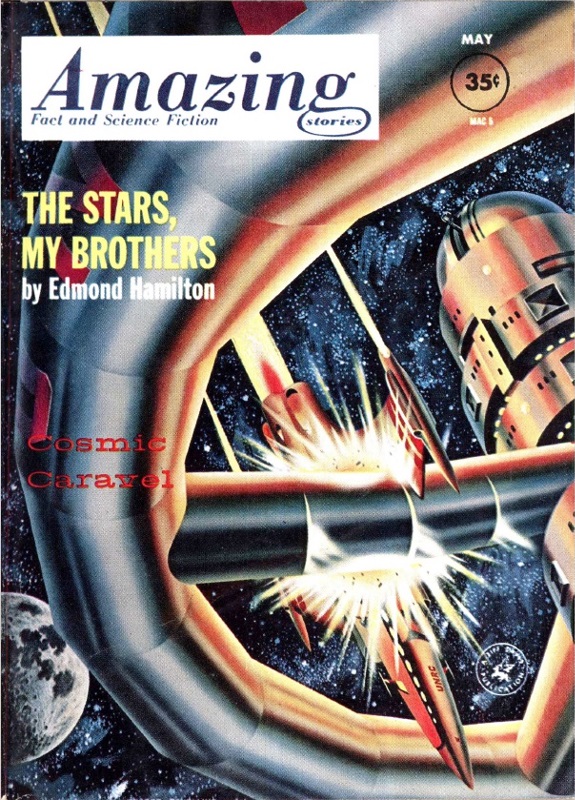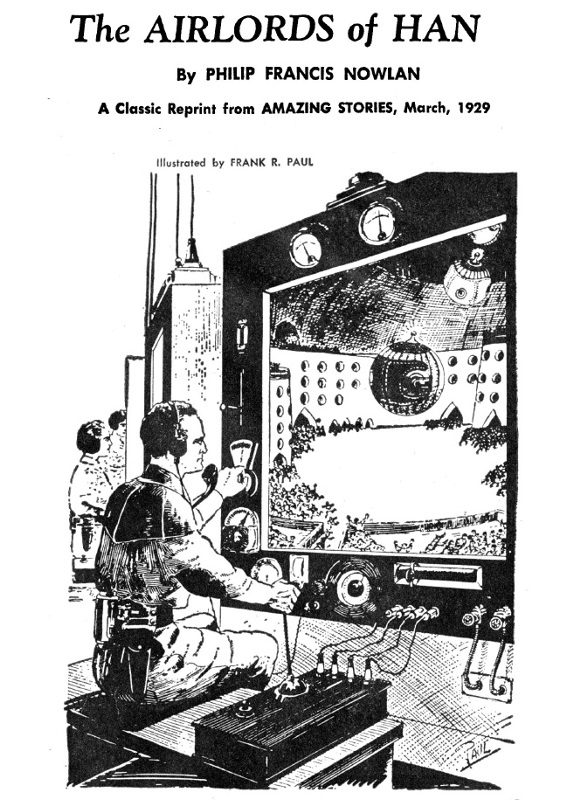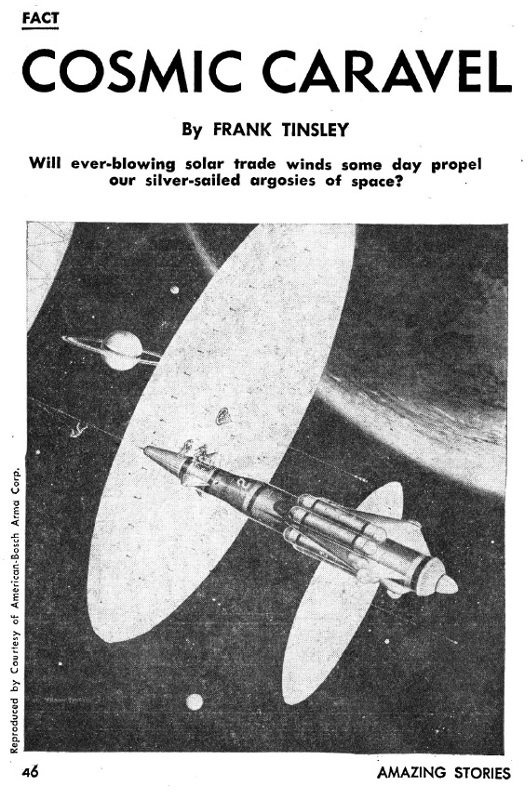
by John Boston

Last month, I asked: can they keep it up? Amazing’s marked increase in quality, that is. Well, no, not this month anyway.

The May 1962 Amazing labors under a large handicap: half of it is given over to The Airlords of Han by Philip Francis Nowlan, the second Buck Rogers novella, reprinted from the March 1929 issue. It starts with a synopsis by Anthony (the Buck has not yet passed) of his emergence from 500 years of suspended animation to discover an America dominated by "the Airlords of Han, fierce Mongolians, who . . . had in their blood a taint not of this earth." But now, the Americans hiding in the woods have mostly retaken the continent while the Han remain huddled in their cities; “the positions of the Yellow and the White Races in America had been reversed.” So it’s Yellow Peril time again!
The good news: Nowlan is quite a facile writer for his time, his style livelier and less stilted than in many of these alleged Classic Reprints. But the substance often gets tedious fast, consisting in good part of catalogues of military tactics, weapons, and the uniforms of the various Gangs (led by Bosses) of rusticated Americans. Here Anthony describes a weapon he designed:
It was a long-gun which I had adapted for bayonet tactics such as American troops used in the First World War, in the Twentieth Century. It was about the length of the ancient rifle, and was fitted with a short knife bayonet. The stock, however, was replaced by a narrow ax-blade and a spike. It had two hand-guards also. It was fired from the waist position.
“In hand-to-hand work one lunged with the bayonet in a vicious, swinging up-thrust, following through with an up-thrust of the ax-blade as one rushed in on one’s opponent, and then a down-thrust of the butt-spike, developing into a down-slice of the bayonet, and a final upward jerk of the bayonet at the throat and chin with a shortened grip on the barrel, which had been allowed to slide through the hands at the completion of the down-slice.”
One wonders if Nowlan might better have been employed writing technical manuals. There are similarly detailed, and much longer, discussions of the opposing forces’ technology—chapter IV is titled “Han Electrono-Science” and V is “American Ultronic Science,” three to four pages each. Even when something actually begins to happen (as Anthony puts it beginning chapter VI, “But to return to my narrative. . .”), Nowlan quickly reverts to verbose digression. When Anthony is captured by the Han, Nowlan spends nearly a page on their physical appearance and their uniforms and gear. He also sociologizes for many pages describing the decadent Han society, which is ultimately dominated by the repairmen, who control the machines on which everyone depends—and no one wants to tangle with their “Yun-Yun.” Later, there is considerably more action, but it too becomes tedious—pages of slaughter and destruction abetted by escalating super-science.
Admittedly, Nowlan is more progressive concerning the role of women than most writers of his era. While his precis of Han society contains a rather bigoted description of women’s place, among the Americans, “men and girls” (as the author puts it) seem more or less equal, both participating in combat. The girls appear to relish their roles, as witness Wilma, Anthony’s wife:
“Like a shriek of the Valkyrie, Wilma’s battle cry rang in my ear as she, too, shot herself like a rocket at a red-coated figure. . . . [Digression while Anthony kills a Han]
“And from the corner of my eye I saw Wilma bury her bayonet in her opponents, screaming in ecstatic joy.”
Despite the racist theme, with passing references to “evil yellow faces” and the “morally degraded race,” plus a disquisition on how the Han lack souls, Nowlan ultimately tries to have it both ways. After the genocide of the Hans, Anthony travels the world and finds everybody pretty nice—“the noble brown-skinned Caucasians of India, the sturdy Balkanites of Southern Europe, [and] the simple, spiritual Blacks of Africa, today one of the leading races of the world, although in the Twentieth Century we regarded them as inferior.” It was just those damn Hans, who weren’t really human but sprang up when extraterrestrials raped the Tibetans.
Sorry, it doesn’t wash. It’s as if D.W. Griffith had ended Birth of a Nation, his famous movie glorifying the Ku Klux Klan, with a placard saying “Just kidding, folks.”
In this time of the Freedom Riders and the sit-ins—but also the time when I hear vile racial slurs virtually daily in this near-Southern small town—who needs this crap? I know, it’s historically important. But so is, say, James Buchanan, and I don’t hear anyone clamoring to bring him back.
One star, and a big “Bah, humbug.”

The lead story is Edmond Hamilton’s longish novelet The Stars, My Brothers, which could have been titled Across the Galaxy in a Bad Mood. Scientist Reed Kieran is killed in a space accident, but finds himself a century later waking up in a starship en route to Altair . He is surprisingly un-delighted at receiving a new life in a new age, and it doesn’t help that his resurrectors are not very nice and don’t want to tell him much. Eventually he learns that they are from the Humanity Party, which believes that “humans should not be ruled by non-humans,” and they have illicitly revived him to be a symbol in a campaign against the planet Sako, where a more intelligent and civilized reptilian species dominates a human population that is “very low in the scale of civilization.” Shaking with rage, Kieran declares, “I have no more use for the idea of the innate sacred superiority of one species over another than I had for that of one kind of man over another.” Now that’s a nice thought, especially after The Airlords of Han.
They land on Sako and are promptly attacked by the primitive humans. Treks and chases ensue and eventually we meet the reptilians, who it turns out are managing the local humans reasonably humanely, like we (sometimes) manage animal populations. The whole thing is as unconvincing as it is didactic, and Kieran’s noble sentiments can’t redeem it. There’s a romantic subtheme that is as sour and implausible as the rest of it. There’s also a conspicuous failure of craft at the beginning: though the actual story doesn’t start until Kieran’s resurrection, there are four and a half pages of mostly irrelevant background—a tenth of the total length—about Kieran’s previous life and how he came to be left dead in his spacesuit, including such data as his street address in Midland Springs, Ohio. One may wonder whether this story was cut down—but not enough or not carefully—from a novel-length piece Hamilton started for one of his now-defunct ‘50s markets. Anyway, two stars mitigated by the author’s good intentions.

John Jakes’s The Protector is a purposefully heavy-handed short story about a guy who after the nuclear war serves as the “protector” for a small town of survivors, or so it seems, and to say anything more would give the whole thing away. It’s effectively oppressive but there’s not much story left when the style and attitude dissipate. Two stars.

Frank Tinsley is back with a science article, Cosmic Caravel, concerning spaceships which may be constructed in orbit and propelled by gigantic sails to catch the “Solar Wind” or “Photon Breeze.” Interesting idea, but the usual dull rendering from Tinsley. Two stars.
Benedict Breadfruit. That is all.
[Yikes! Months like this make me feel like a harsh taskmaster. Let's hear a round of applause for poor young Boston, who suffered so. I am grateful, in particular, for his taking on the Buck Rogers tale. Better luck next time, Master John! (Ed.)]

> story was cut down
I've noticed that about a *lot* of Hamilton's work. Many of them seem to start and stop without forming a complete story. But the most annoying part is, though I generally like Hamilton's writing, most of his stuff is so similar I often have the feeling I've read it before…
I don't know if Hamilton lacks the imagination to write a different way, or if he just found a style that worked well enough and sticks to it.
Hamilton is great at painting big pictures and mood, but his stories ususally turn out as a chain of loosely (or un-)connected vignettes.
The "Airlords of Han" story seemed awfully familiar, but I don't recognize the name. I might have found it and the first story in some omnibus "Buck Rogers" edition. About the only thing I remember is that it's one of the rare books I failed to finish, though I can't remember why.
I rather enjoyed the Hamilton overall. The first few pages seemed necessary to establish the protagonist as a person of our time (well, near future), and I thought some of the best writing was in that section. He started to lose me with "humans" being found native to planets all over the galaxy, but then he won me back at the end. Hamilton was always a thoughtful author, even back in the pulp days. I wonder what the result would be like if he and Leigh Brackett were to collaborate the way C.L. Moore and Henry Kuttner were.
"The Protector" wasn't terrible, but I figured out where it was going fairly quickly. Once I did, the rest of the story was just waiting for the "reveal", and Jakes took a little too long getting there. Jakes has been around for a while, but seems uneven. Some of his stuff has been pretty good, if not the best.
The solar sail concept is intriguing. It seems like it might take quite a while to get up to an appreciable speed, but perhaps not. It would certainly give new life to those stories that lean heavily on comparisons with the days of sail. New Hornblowers of space!
I gave Buck Rogers a complete miss. I never thought those stories were very good, even compared to its contemporaries.
I've said before that I like Feghoots. A well-executed pun can be a wonderful thing. These Breadfruit things are abominable. And this may have been the best one yet. I hope Miss Goldsmith drops this experiment soon. Garrett just isn't anywhere near as funny as he thinks he is.
Thanks for your review of the Not-Yet-Buck Rogers story. This sort of thing is interesting to read *about*, though I have no desire to actually slog through it myself. So thanks for taking that hit for the rest of us.
I thought the Hamilton wasn't too bad, and the Jakes pretty darn good. I didn't bother with the reprint. I know this must be a financial decision on the part of the magazine, but I wish they would drop this feature and print new stories; or, at least, select reprints that have some value other than being old.
At the very least they could dig through their own archives and find some "best of" stories that haven't been anthologized yet, or much.
I didn't start buying the magazines until a few years ago; anything more than five or so years old that hasn't been out in book form, I probably haven't seen it and have no practical way to get it. It's not like I can get an old copy of If or Analog from the library.
Unfortunately their archives are mostly crap. AMAZING notoriously deteriorated during the 1930s until finally it was bought out by Ziff-Davis, which turned it into a determinedly juvenile magazine under the editorship of Ray Palmer, whose motto was "gimme bang-bang." This approach continued into the early 1950s. Then Z-D changed the magazine to digest size and decided to shoot for quality in the accustomed manner: they paid much higher rates. So AMAZING was a pretty high-quality magazine in 1953 and '54. Then the money dried up and it reverted to a low-paying and purposefully lowest-common-denominator production with contents produced almost exclusively by a stable of staff writers using multiple pseudonyms. Goldsmith has been digging out of that hole since she became editor. So they have a limited pool of decent old material to work with, problem compounded by the fact that the selections seem to be made by Sam Moskowitz, who is certainly one of the most knowledgeable experts about early SF. But knowledge does not confer taste, as he demonstrates more often than not.
I tend to agree with Victoria. The Hamilton was interesting if flawed. The Jakes was fine – it read quite like a Twilight Zone episode. On that basis it would have been an OK issue. But it is difficult to see how anything could have overcome the Buck Rogers reprint, where John was spot on in his assessment. Hopefully the money saved goes into future issues. Let's not give up on Cele yet!
I'm beginning to wonder if the main reason we're seeing so many… uh… lower-quality stories is because what they're printing is the best they've had to pick from.
If that's true, short-form science fiction is probably pretty close to being dead. And since the magazines are the traditional entry to a book contract, that makes me worry about the whole genre.
It's always darkest before dawn. IF is picking up. I've got hope.
Miss Goldsmith makes no bones about not knowing much about the history of the field when Ziff-Davis hired her to staff their experiment PEN PALS and kept her around so that Someone working on the fiction magazines was actually working, once Howard Browne lost interest and started running all those We Don't Want It Good So Much As Thursday stories, a trend that if anything intensified during Paul Fairman's anti-editoriship…I understand that such things as Kate Wilhelm's first story was pulled out of the slushpile by Goldsmith and probably the only story in its issue of FANTASTIC, which by the way was the first trial balloon for that dreadful DREAM WORLD, that wasn't purchased by Fairman as yardgoods from the regular handful of contributors…clearly including Garrett, Henry Slesar, Robert Silverberg, Harlan Ellison and Milton Lesser, who, like Slesar, seems to be mostly writing mystery and suspense fiction these days, and signing himself Stephen Marlowe. Which is a very long-winded way of saying I don't think Miss Goldsmith has yet had time to familiarize herself with the history of the field (she is trying to put out 24 issues a year on a slim budget, after all), and thus depends way too much on Moskowitz for these "classics"…as Damon Knight has noted, Moskowitz does have a highly developed taste…for these clunky things that clattered through the night in 1932, when his own less than glabrous writing style was also set in particularly unforgiving stone, or perhaps simply a freezerburned tv dinner template.
Just a quick appendix to fix an address issue…I mistyped!
I came along just as the Goldsmith era was coming to an end. But it was a nice introduction to magazine science fiction.